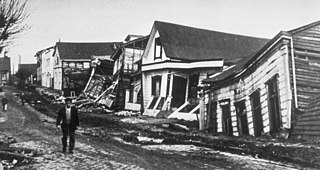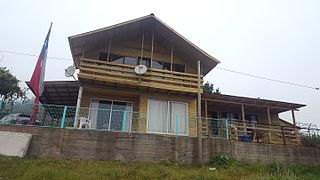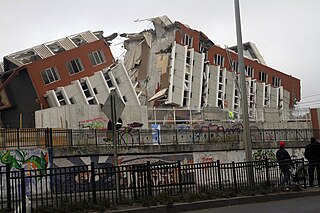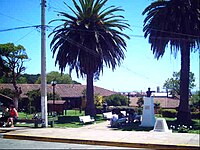
Valparaíso is a major city, commune, seaport and naval base facility in Valparaíso Region, Chile.

The 1960 Valdivia earthquake and tsunami or the Great Chilean earthquake on 22 May 1960 was the most powerful earthquake ever recorded. Various studies have placed it at 9.4–9.6 on the moment magnitude scale. It occurred in the afternoon, and lasted for approximately 10 minutes. The resulting tsunamis affected southern Chile, Hawaii, Japan, the Philippines, eastern New Zealand, southeast Australia, and the Aleutian Islands.

The Maule Region is one of Chile's 16 first order administrative divisions. Its capital is Talca. The region derives its name from the Maule River which, running westward from the Andes, bisects the region and spans a basin of about 20,600 km2. The Maule river is of considerable historic interest because, among other reasons, it marked the southern limits of the Inca Empire.

Iquique is a port city and commune in northern Chile, capital of both the Iquique Province and Tarapacá Region. It lies on the Pacific coast, west of the Pampa del Tamarugal, which is part of the Atacama Desert. It has a population of 191,468 according to the 2017 census. It is also the main commune of Greater Iquique. The city developed during the heyday of the saltpetre mining in the Atacama Desert in the 19th century. Once a Peruvian city with a large Chilean population, it was conquered by Chile in the War of the Pacific (1879–1883). Today it is one of only two free ports of Chile, the other one being Punta Arenas, in the country's far south.

Talca is a city and commune in Chile located about 255 km (158 mi) south of Santiago, and is the capital of both Talca Province and Maule Region. As of the 2012 census, the city had a population of 201,142.

The Diocese of Linares is a Latin Church ecclesiastical territory or diocese of the Catholic Church in Linares, Chile. It was established by Pope Pius XI on October 18, 1925 in his papal bull Notabiliter Aucto.

Cauquenes, a city and commune in Chile, is the capital of the Cauquenes Province and is located in the Maule Region.

San Javier is a Chilean city and commune located in the Province of Linares, Maule Region. The city lies in the geographical center of the country, some 270 km (168 mi) south of Santiago, 31 km (19 mi) to the northwest of the provincial capital, Linares, and 24 km (15 mi) to the south of Talca, the regional capital. The Pan-American Highway passes through the commune of San Javier, touching tangentially the eastern side of the town. A paved road connects San Javier with Colbún, Colbún dam lake and Panimávida and Quinamávida hot springs.

Pelluhue is a town and commune in the Cauquenes Province of central Chile's seventh region of Maule.

Chanco is a Chilean town and commune located in Cauquenes Province, Maule Region.

Cauquenes Province is one of four provinces of the central Chilean region of Maule (VII). The provincial capital is the city of Cauquenes.
Retiro is a town and commune in Chile, located in Linares Province, in the seventh region of Maule.

The 1751 Concepción earthquake was one of the strongest and most destructive recorded quakes in Chilean history. It struck the Central Valley of the country, destroying the cities of Concepción, Chillán, Cauquenes, Curicó and Talca, probably on May 24, 1751, although there is currently a debate among scholars as to the exact date of the earthquake.

The 2010 Chile earthquake and tsunami occurred off the coast of central Chile on Saturday, 27 February at 03:34:12 local time, having a magnitude of 8.8 on the moment magnitude scale, with intense shaking lasting for about three minutes. It was felt strongly in six Chilean regions that together make up about 80 percent of the country's population. According to the United States Geological Survey (USGS) the cities experiencing the strongest shaking—VIII (Severe) on the Mercalli intensity scale (MM)—were Concepción, Arauco, and Coronel. According to Chile's Seismological Service, Concepción experienced the strongest shaking at MM IX (Violent). The earthquake was felt in the capital Santiago at MM VII or MM VIII. Tremors were felt in many Argentine cities, including Buenos Aires, Córdoba, Mendoza, and La Rioja. Tremors were felt as far north as the city of Ica in southern Peru. It is the largest earthquake to hit Chile since the 1960 Valdivia earthquake.
The timeline of relief efforts after the 2010 Chile earthquake of 27 February 2010 involves the sequence of events in the days following a highly destructive 8.8 Mw earthquake with an epicentre just offshore of the Maule Region, see Maule, Chile.
03:34: Earthquake in Chile is a 2011 Chilean film directed by Juan Pablo Ternicier and written by Mateo Iribarren. The film narrates three different stories based on the 2010 Chile earthquake.
Club de Deportes Independiente de Cauquenes is a Chilean Football club, their home town is Cauquenes, Chile. They currently play in the third level of Chilean football, the Segunda División de Chile.

The 2010 Pichilemu earthquakes, also known as the Libertador O'Higgins earthquakes, were a pair of intraplate earthquakes measuring 6.9 and 7.0 that struck Chile's O'Higgins Region on 11 March 2010 about 16 minutes apart. The earthquakes were centred 15 kilometres (9.3 mi) northwest of the city of Pichilemu.

The 1928 Talca earthquake occurred on 1 December at near Curepto, Maule Region, Chile, with an estimated magnitude of 7.6 MW, 8.3 MS and 7.9 ML. In Talca, it lasted 1 minute 45 seconds.
The 2018 Copa Chile, was the 39th edition of the Copa Chile, the country's national football cup tournament. Santiago Wanderers were the defending champions, but lost to Palestino in the second round of the competition. Palestino went on to become champions after defeating Audax Italiano in the final by an aggregate score of 4–2.
















